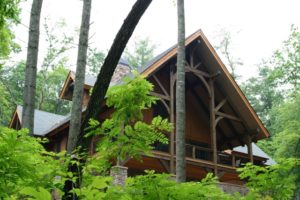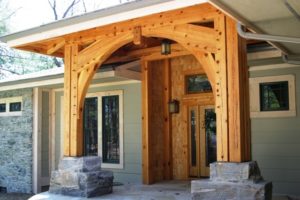Many times timber frame home owners, craftsmen, and builders will liken the timbers used in building a house with fine furniture. While the craftsmanship and detail that goes into these structures are often comparable to furniture construction, the timber frame finishes that are used to protect and preserve the wood are far different than what is used in the furniture industry.
Timber Frame Lumber Versus Furniture Grade Lumber
There’s a big difference between the kiln-dried, dimensionally stable lumber that’s used to create your furniture and the heavy timbers used to build your home.
Wood used in furniture building is kiln dried and will have little shifting, swelling or shrinking. Varnishes, urethanes and lacquers seal the wood to maintain the moisture level in the wood and protect the surface from damage.
 Lumber used to build a timber frame home needs to breathe. It moves because of varying moisture content in the cells of the wood, stresses that are caused by the building itself and the changes in atmospheric pressure and temperature.
Lumber used to build a timber frame home needs to breathe. It moves because of varying moisture content in the cells of the wood, stresses that are caused by the building itself and the changes in atmospheric pressure and temperature.
Green timber attempts to maintain moisture equilibrium. The chemical composition of the green wood and the constant dispersal of moisture will eventually oxidize and break down a finish that seals the wood.
If the builder is using re-sawn lumber, the reverse process occurs. The dry timber fibers will absorb moisture from the air. The wood needs oils to reduce brittleness and provide moisture as new movement and stress factors from the re-purposing come into play.
The Purpose Of A Wood Finish On Timber Frame Lumber
Whether you’re using green wood or re-cycling lumber, there are three objectives in the finishing process of your structure.
Foremost, the wood must be stabilized. The goal is to minimize the shrinking process, slow down drying and reduce checking. This ensures that all the joinery remains tight and there is no danger of shifting, movement or cracking to the point of instability.
Second, a finish is used to enhance the beauty of the wood. You want your house to look its best, and finishing the wood to play up the natural colors, grain and texture increases the charm of your unique and distinctive home.
The third objective of a good finish is its ease of application. Although this is a job that isn’t performed often, it’s a big undertaking. Maintaining and refinishing all that wood over the years is certainly something to consider when choosing a finish for these massive and towering timbers. As well as being easy to use, the finish should be safe for both the environment and those who take on the refinishing task.
So, What Makes a Good Timber Frame Finish?
To make it easier for you to shop for your timber frame finish, I’ve made a list of qualities that proper products should have. Return to this list any time you feel confused about a product’s specifications and promises.
- a proper timber frame finish product should be non-toxic
- it shouldn’t contain any heavy metals or driers of any kind
- a quality timber frame finish product should be easy and quick to apply
- drier-free finishes will be easy to wipe off without lap marks or buildup of gummy residue if applied in excess
- a good finish should be safe for the environment, and those who take on the refinishing task
- a proper finish will contain only pure ingredients which will allow the wood to breathe with little discoloration over time
- a high quality finish will have specific qualities for interior or exterior surfaces such as UV protection, wood preservatives to resist and kill mildew, mold and fungus
- a versatile finish will be thin enough for quick penetration but contain enough solids for a rich water-resistant coat
Timber Frame Finishes – Products That Protect Your Investment
Most commercial products contain driers to speed up the drying time of the finish. Typically, these finishes are mostly solvents with very little protective material and require a number of applications. This effectively seals the surface of the wood. The metallic driers are also toxic. These products are not a good choice for your timber frame home.
 Choose a penetrating oil finish that is drier-free, so the wood has ample opportunity to absorb the oil. You should be able to apply it easily and quickly to a large surface, and the excess product should be easy to wipe off without lap marks or a buildup of gummy residue on the surface of the wood. This type of natural oil finish continues to wick into the fibers of the wood long after the surface is dry.
Choose a penetrating oil finish that is drier-free, so the wood has ample opportunity to absorb the oil. You should be able to apply it easily and quickly to a large surface, and the excess product should be easy to wipe off without lap marks or a buildup of gummy residue on the surface of the wood. This type of natural oil finish continues to wick into the fibers of the wood long after the surface is dry.
Use only pure ingredients to ensure there is little discoloration over time. This kind of finish remains flexible, resilient, allows the wood to breathe, and absorbs into the cell structure of the wood.
Heritage Natural Finishes is a great natural product and is widely used in the timber frame industry. Check it out at Heritage Natural Finishes.
We wouldn’t be recommending these products if we weren’t timber frame builders ourselves. We’ve built our own constructions and have lived to tell the story. We can not stress enough how important it is to pay attention to the quality of the elements that help you bring your timber frame together and keep its beauty intact over the years.
Exterior Surfaces Require Extra Protection
The outside of your timber frame home requires protection that goes beyond the penetrating oil finish you’ve chosen for your interior surfaces. You need to protect the wood from the effects of sunlight, mildew and insect damage, as well as maintaining the moisture level and minimize the checking and shrinking.
 Unless you live in a very arid part of the country, your wood finish should have a mildewcide. These exterior products should be fortified with a wood preservative to resist and kill mildew, mold and fungus.
Unless you live in a very arid part of the country, your wood finish should have a mildewcide. These exterior products should be fortified with a wood preservative to resist and kill mildew, mold and fungus.
Regardless of where you live, your exterior finish should have UV protection. This additive protects the wood against the deteriorating effects of the sun’s rays and helps to decrease the natural graying of the wood. If your home is situated in an area where termites or other insects are a problem, you may need to spray the wood with borax or other pesticide before applying your wood finish.
Choose well and choose wisely when deciding which finish is right for you and your timber frame home. Do your own research, ask questions and get the latest data sheets of product specifications. Don’t shortchange yourself or your home, as the consequences of a poor choice can haunt you for decades.
I Live in Colorado and I have been a remodeling contractor for 44 years. My lumber yard recommended a rough sawn Doug fir for beam materials , we live in the country and a rustic look was fine with us. There are many imperfections including black stained marks rough edges (expected), obviously I want to reduce checking and movement , I have limited experience with timber frame, that’s why I went with their recommendation since they supply a lot of builders in Aspen area. My project is tiny by comparison , but I am using some large timber, 12×12,6×8, 6×6,4×6. Would like longevity of finish , dark stain, stability of finish. The heritage product looks like a good fit,but here comes the bone headed question . Can I power wash first to clean surfaces or am I injecting to much moisture. Perplexed in Colorado
You can pressure wash the timbers but you will raise the grain on them. It can be a good look but try a little area before committing to it all. After you pressure wash them and let them air dry you will be good to apply the Heritage finishes.
I have a post and beam style porch with oak beams. I am researching the best product to protect them from the elements. What do you recommend?
We like Heritage Natural Finishes
We have ruff sawn hemlock for timber beams on our porch. What do you recommend to seal it to keep it from graying ?
All exposed wood will weather over time. We do recommend Exterior Finish from Heritage Natural Finish.
I have had good results with Ready-Seal. Before that I had acceptable results from Flood products. Never tried Heritage, so can’t directly compare.